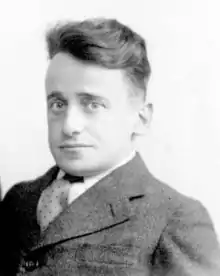Alexander Katan
Alexander Katan (8 November 1899 - 27 January 1943) was a Dutch Jewish physically disabled accountant, translator, and teacher, who was murdered by the Nazis in the Holocaust, after which time his photographs were notoriously on display in various museums.
Alexander Katan | |
|---|---|
 | |
| Born | 8 November 1899 |
| Died | 27 January 1943 (aged 43) |
| Occupation |
|
| Spouse(s) | Julia Sophie Elze |
| Children | Alphons Katan |
Early life
Alexander Katan was born in Rotterdam, one of eight children in a Jewish family. He was a dwarf, due to spondyloepiphyseal dysplasia congenita.[1]
As an adult, he moved to Leeuwarden, married Julia Sophie Elze, also a dwarf, and they had one son, Alphons, born in 1930, who was not a dwarf. While using a wheelchair due to his weak limbs, Katan devoted himself to study, ultimately mastering six languages and working as an accountant and a translator, as well as tutoring students in his home.
Holocaust
Katan was arrested by the Germans in July 1942, ostensibly due to his and his family's refusal to wear the Jewish star the Nazis required Jews to wear on their clothing. His wife and son were arrested soon afterwards.
Katan was taken first to Amersfoort concentration camp; then he arrived on November 3, 1942, at Mauthausen concentration camp. He was assigned the number 13992.
His wife was sent to Ravensbrück concentration camp and then to Auschwitz. While Josef Mengele would later gain a notorious reputation for his interest in and medical experiments on dwarfs, Mengele had not yet begun working in Auschwitz at the time Sophie was taken there. Upon arrival, she was immediately gassed. Their son was transported to Westerbork but was ultimately released due to the efforts of his aunt, who argued, untruthfully, that Alphons' non-dwarf stature indicated that he was not Katan's son.
Shortly after arrival at Mauthausen, Katan attracted the attention of the camp's doctors. They subjected him to a number of experiments, considering his short stature and bent spine to be the embodiment of Jewish degeneration. Among other treatment, they photographed him first clothed in his concentration camp prisoner garb, then naked. On January 27, 1943, Karl-Joseph Gross ordered him killed with an injection to the heart and stripped his flesh from his bones, which then were reassembled for display. The skeleton was taken to the SS Medical Academy near the University of Graz.[2][3]
Post-Holocaust
Following the end of the Holocaust, Mauthausen concentration camp became open to visitors. Four photographs of Katan were kept on prominent display in the museum there: Katan dressed in his concentration camp prison garb, a frontal naked photo, a rear naked photo, and a photo of his skeleton. In 1994, Alphons Katan went to Mauthausen to visit the place he believed to be his father's final resting place, but was horrified to see his father's photographs on display, first stripped of clothing, then of flesh.
Alphons Katan worked to get the photographs removed from display at Mauthausen, a mission that was ultimately successful. He continues to try to find his father's bones to give them a decent burial.
In 2000, Hedda van Gennep, a Dutch documentary filmmaker, created the film Dood Spoor?[4] (Dutch for: Dead End?) that tells the story of the son's quest to have the photographs removed.
References
- Betty M. Adelson, The Lives of Dwarfs: Their Journey from Public Curiosity toward Social Liberation. Rutgers University Press, 2005, p. 42
- "Little People". Retrieved 3 May 2016.
- Giants: The Dwarfs of Auschwitz. Eilat Negev and Yehuda Koren. Robson Press, 2013.
- http://www.archiefeemland.nl/collectie/bibliotheek/detail?id=7e450e66-6512-11e0-a7c0-893487041761
External links
- Dood spoor at the Dutch Film Festival